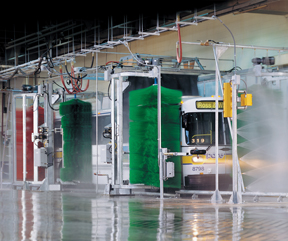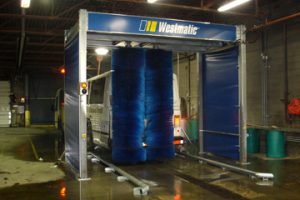The easiest, fastest and least expensive measure bus and motorcoach operators can take to make a lasting impression is to keep the vehicles washed and shining. How clean is clean? A question both private and public operators are asking to promote a more positive public image and a more inviting option to upscale riders.
The extra care given to the exterior surfaces of transit buses has become a greater concern with the advent of sophisticated bus-wrap advertising, and with transit buses sporting a more polished upscale appearance. A bus wash system represents a significant capital investment from initial planning to installation.
The reasons for choosing one system over another run the gamut of variables — space and site considerations, the size of the fleet, allotted time and labor, water usage, water reclamation and a host of environmental regulations. The key is making the correct choice of the most appropriate and cost-effective wash system.
 Hybrid brush and spray handle every situation
Hybrid brush and spray handle every situation
Ross & White Company
Cary, IL
Ross & White Company, Cary, IL, has been designing, manufacturing and installing transit vehicle wash equipment for 75 years. The company says today’s challenge is to balance costs with the capability to wash an entire fleet comprised of different types of vehicles. Ross & White works with many companies that run standard transit buses, articulated buses, the higher commuter motorcoaches and body-on-chassis paratransit vehicles, and require one system in one wash bay to accommodate each type. The company says it meets that challenge with its highly adaptable hybrid bus wash systems that combine brush and touchless technology.
Ross & White president Jeff Ross says the combination of brush and spray cleans evenly and gets into wheels, bike racks and undercarriages — those hard to get areas where brushes alone do not normally reach.
The brushes and sprays are easily modified to fit the wash requirements for each bus that comes through the system.
 The Compact drive-through is ideal in small spaces
The Compact drive-through is ideal in small spaces
Westmatic
Troy, MI
Westmatic, Troy, MI, says its Compact bus washing equipment is a particularly effective drive-through system for existing facilities with limited space. Available in two-, four- and six-brush configurations for areas up to 20 by 30 feet, the Compact features lights that signal the driver to stop and move ahead at each step of the wash and rinse cycle. The system utilizes an automatic speed control system that prevents driver error during the wash process.
The six-brush Compact is the most popular model. Westmatic president Robert Sundell says the proprietary split brush configurations are a proven solution to damage that often occurs from buses with bike racks coming through the bus wash. The eco-friendly Westmatic equipment also features a mirror protection program that washes around the mirrors to prevent damage. The Compact is also available with a touchless high-pressure arch.
 The ACC-Eco-Powerbrush is fast, efficient and economical
The ACC-Eco-Powerbrush is fast, efficient and economical
ACC International
Niagara Falls, NY
The ACC-Eco-Powerbrush from ACC International is well-balanced rotating brush apparatus a technician walks and pushes around the stationary bus or motorcoach, washing the bus in a pulling motion.
ACC International says the typical wash with this eco-friendly system takes less than 10 minutes using only three to five gallons of water per minute. James Stieva says fewer chemicals are needed because the spinning brush does most of the work to remove dirt and grime.
The ACC Eco-Power Brush installs in most existing wash areas, both indoor and outdoor, and does not require floor-mounted tracks or hardware.
